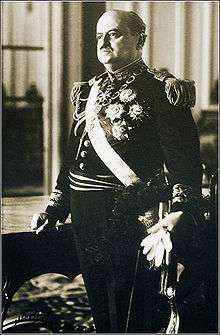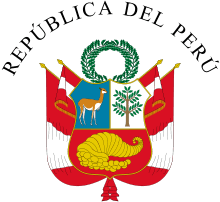Óscar R. Benavides
| Óscar Raymundo Benavides Larrea | |
|---|---|
 | |
| 67th President of Peru | |
|
In office February 4, 1914 – August 18, 1915 | |
| Preceded by | Guillermo Billinghurst |
| Succeeded by | José Pardo y Barreda |
| 76th President of Peru | |
|
In office April 30, 1933 – December 8, 1939 | |
| Preceded by | Luis Miguel Sánchez Cerro |
| Succeeded by | Manuel Prado y Ugarteche |
| Personal details | |
| Born |
March 15, 1876 Lima, Peru |
| Died |
July 2, 1945 (aged 69) Lima, Peru |
| Nationality | Peruvian |
| Spouse(s) | Francisca Benavides Diez Canseco |
Óscar Raymundo Benavides Larrea (March 15, 1876 – July 2, 1945) was a prominent Peruvian field marshal, diplomat, and politician who served as the President of Peru from 1914 until 1915 and again from 1933 until 1939.
He is also the accredited with the quote: "For my friends everything, for my enemies the law". [1]
Early life
He was born in Lima on March 15, 1876. The son of Miguel Benavides y Gallegos, Sargeant Major of the National Guard, and Erfilia Larrea, Peruvian socialite. After attending the Guadalupe High School (Colegio de Nuestra Senora de Guadalupe) in Lima, Benavides entered the Military School of Lima (la Escuela Militar) and in 1894, the "Dos de Mayo" Artillery Brigade. In 1901, he was promoted to Captain; and in 1906, at age 30, he graduated with top grades as Sergeant Major at the Military Academy in Lima, directed by the French Military Mission. The Government sent Benavides to France to complete his military training,[2] after which the French Republic distinguished him with the Cross of the Legion of Honor.
Caquetá River Campaign
Upon returning to Peru in December 1910, Benavides was designated commanding officer of Infantry Battalion N° 9, garrisoned in Chiclayo, on the Northern Pacific Coast of Peru. In February 1911, the Peruvian Government ordered Benavides to lead Battalion Nº 9 to the Northeastern border with Colombia in Peruvian Amazonia. Colombia had established a fortified post at La Pedrera on the southern bank of the Caquetá River, which, according to the Porras-Tanco Argáez Treaty of 1909, was within Peruvian territory.
Battalion N° 9 had to travel more than 2,000 kilometers, passing over the roadless Andean range at Cajamarca and Chachapoyas to the Amazonian jungle. At Balsapuerto, at the headwaters of the Huallaga River, the expedition prepared rafts and obtained canoes,[3] traveling downstream to Yurimaguas on the Huallaga, and thence by boat to Iquitos on the Amazon River. The naval expedition, consisting of one gunboat and four boats, set out from Iquitos on June 29, 1911, four months after departing Chiclayo. On July 10 it faced La Pedrera with blazing flags. After an exchange of notes in which the Colombian Commander refused to vacate the position, Commander Benavides initiated the attack. The triumph of the Peruvian forces was complete. But on July 24, to his dismay, Commander Benavides was informed that the Peruvian and Colombian Governments had signed a treaty whereby the Peruvian forces were to abandon the Caquetá and to withdraw to the Putumayo River.
On July 28, 1911, the Peruvian forces still at La Pedrera celebrated Independence Day. But they lacked equipment to protect themselves from the climate, diseases, and infections endemic to the region. On July 29, the troops underwent a terrible epidemic of yellow fever and beriberi. Lacking medicines, the troops were cruelly decimated.
On August 4, Commander Benavides returned to Iquitos. He was promoted to the rank of Infantry Colonel; but Benavides wrote in his diary: "I have suffered so much that the victory obtained and the ovations and promotion conferred on me have not gratified me in the way many assume, as they would have without so much misfortune".[4]
The Government sent Benavides to Europe for treatment of beriberi. When he returned to Peru on April 8, 1912, he was received as a national hero, and in his honor a parade took place in Lima, along the Jirón de la Unión to the Plaza de Armas. On this occasion, he met his distant cousin Francisca Benavides Diez Canseco, whom he married a few months later. Benavides was appointed to the position of General Commander of the Third Region in Arequipa. In November 1913, Benavides was designated Head of the Army General Staff in Lima.
On July 16, 1913 he was shot in the arm in a bandit attack on his troops. He was shot again on the same day by an ally's stray bullet. Neither of the wounds were fatal (or even near fatal), but it did put a damper on his fighting abilities.
First presidential term
In 1913, the President of Peru was Guillermo Billinghurst, who had been elected in 1912 with the backing of workers' movements. Faced with the opposition of a significant sector of Congress, Billinghurst planned to dissolve Congress. Some Congressmen conspired to depose the President, and obtained the backing of Lieutenant Colonel José Urdanivia Ginés, head of a section of the Army General Staff. Billinghurst attempted to arm the population to fight the Armed Forces. The conspirators approached Colonel Benavides, who agreed to back them, both to defend the Constitutional order and to avoid a division of the Armed Forces (Basadre, p. 3733–3734). On February 4, 1914, the Army, under the command of Benavides, obtained from President Billinghurst a statement of willingness to negotiate. Billinghurst was deposed and exiled to Chile, where he died the following year.
As Chief of Staff, Benavides was appointed by the conspirers to preside over a Government Council. On May 15, the National Congress designated him as Provisional President. On December 17, Benavides ascended to General of Brigade (Tauro, p. 285). During the 18 months of his government, Benavides restored political order and stability. Regarding his cabinets, Basadre (p. 3772) writes: "General Benavides’ choice of collaborators was cautious and balanced". Benavides called general presidential elections which were won by José Pardo y Barreda, who governed from August 18, 1915.
President Pardo sent Benavides to Paris (1916) as an observer of World War I; he was a witness at the Battle of Verdun. Subsequently (1917), Pardo sent him to Italy as Extraordinary Emissary and Plenipotentiary Minister. On July 4, 1919, Augusto B. Leguía became President of Peru as the result of a coup d´état against Pardo. In December 1920, Benavides resigned from the post in Rome and returned to Lima.
Leguía feared that Benavides would organize a revolt, and had him arrested on May 3, 1921. Benavides and twenty-five other citizens were boarded as prisoners on the Paita steamship destined to Sydney, Australia. A revolt, commanded by Benavides, captured the ship’s captain and officers, and changed the route to Costa Rica. From Costa Rica. Benavides moved to Panama and thence to Guayaquil (Ecuador) where he renewed contacts with elements opposing Leguia. In November 1927, he moved to France.[5]
Second presidential term
On August 22, 1930, Lieutenant Colonel Luis Miguel Sánchez Cerro started a revolution in Arequipa, and Leguía resigned from the Presidency. Sánchez Cerro was invested with the rank of Provisional President. On October 3, Benavides was appointed to the post of Extraordinary Emissary and Plenipotentiary Minister in Spain and, in February 1932, in England. The Government recalled Benavides and appointed him General-in-Chief of the Council of National Defense (March 27, 1932), in charge of the Peruvian forces in view of a renewed armed conflict with Colombia. On March 31, he was promoted to the rank of Division General.
Sánchez Cerro was assassinated on April 30, 1933. To restrain ensuing turmoil, the Constituent Assembly proclaimed Benavides Constitutional President of the Republic for the completion of the period initiated by Sánchez Cerro. Benavides signed the new Peruvian Constitution, which replaced that of 1920 (which had been in effect since the administration of Augusto B. Leguía). The 1933 Constitution lasted until 1979.
The primary concerns of the new Government were: to resolve the conflict with Colombia (peace was negotiated in May 1934); and to assuage internal political agitation (Tauro, vol 1, p. 266; Orrego, p. 894) for which purpose, Benavides outlawed the Alianza Popular Revolucionaria Americana (APRA), arguing that it was an international party, prohibited by the Peruvian Constitution, and repressed the Communist Party for the same reason. Benavides called presidential elections in 1936; but the results were annulled as they favored the investment of Luis Antonio Eguiguren who, according to the Government, had the vote of the APRA.
Benavides obtained the extension of his mandate for three more years, during which he governed under the motto “Order, Peace, and Work.” He strengthened the Armed Forces and purchased modern armaments. The Navy Dock and Ship Dry Dock of Callao were built; the Pan-American Highway was completed from Ecuador to Chile along the Peruvian coast, as was the Central Highway crossing the Andes east from Lima to the Amazonian Forest, as far as Tingo María. Road and bridge tolls were abolished, thus implementing freedom of the highways.[6]
The Government built living quarters and dining halls for workers and their families, and instituted Workers’ Social Security, and a new Civil Code. Tourism was encouraged and Tourist Hotels were planned for Peru’s principal cities. The National Census was planned and organized, but was only effected in 1940, by the following Government. During Benavides' term in office, the second phase of remodeling the Government Palace of Peru was initiated, as well as the Palacio de Justicia ("Palace of Justice").[7]
On December 8, 1939, Benavides handed over the presidential mandate to Manuel Prado y Ugarteche, the winner of the General Elections of that year. On December 19, Prado honored Benavides with the title of Grand Marshal of Peru.
Foundation of the National Democratic Front
Benavides served as Peruvian Ambassador in Madrid (1940), and in Buenos Aires (1941–1944). He returned to Peru on July 17, 1944, and was among the founders of the Frente Democrático Nacional (FDN) (National Democratic Front). Benavides died in Lima on July 2, 1945, after the confirmation of the triumph of the FDN Presidential Candidate, José Luis Bustamante y Rivero.[8]
Sources
- El Mariscal Benavides, su vida y su obra. 1976, 1981. Lima, Editorial Atlántida, 2 volumes.
- Basadre, Jorge. 1963. Historia de la República del Perú, Fifth Edition, Volume VIII. Lima, Ediciones Historia.
- Orrego, Juan Luis. 2000. La República oligárquica (1850–1950). In Historia del Perú, Lima, Lexus.
- Tauro (del Pino), Alberto. 1988. Enciclopedia ilustrada del Perú. Lima, Peisa.
References
| Political offices | ||
|---|---|---|
| Preceded by Guillermo Billinghurst |
Interim President of Peru 1914–1915 |
Succeeded by José Pardo y Barreda |
| Preceded by Luis Miguel Sánchez Cerro |
President of Peru 1933–1939 |
Succeeded by Manuel Prado y Ugarteche |
